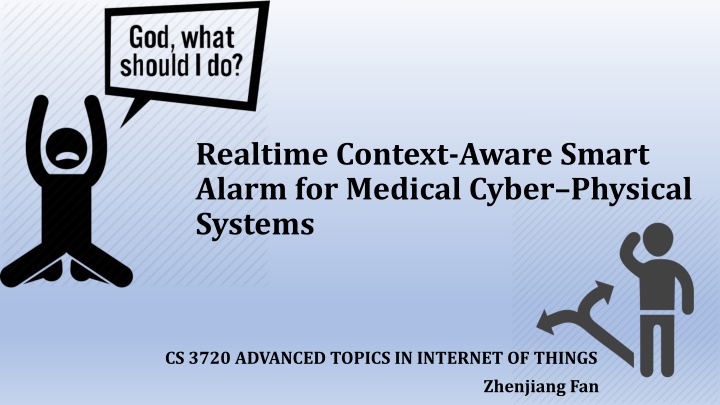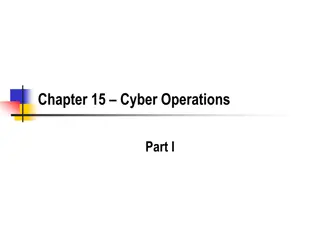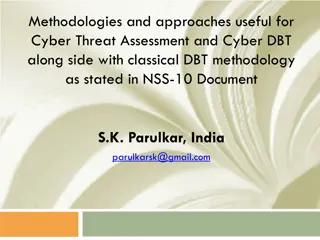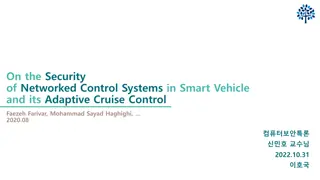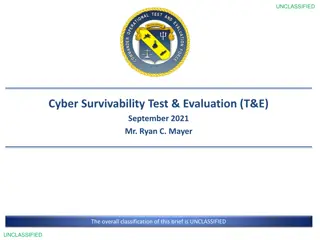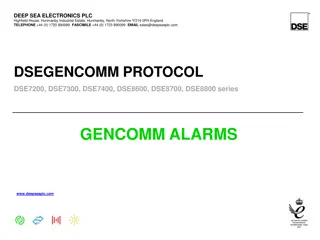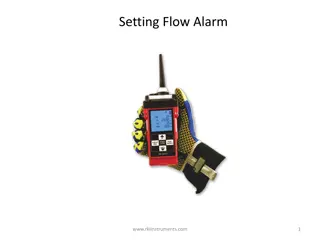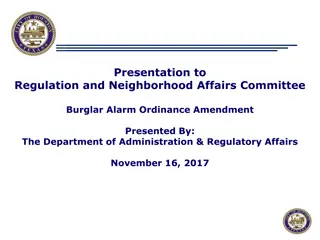Realtime Context-Aware Smart Alarm for Medical Cyber-Physical Systems
The demand for healthcare services continues to rise, necessitating the use of Medical Cyber-Physical Systems (MCPS) for high-quality care. Existing medical devices lack precision in alarming and fail to provide diagnostic information about patients' conditions. This project proposes a method to build models that analyze biomarkers and causal relationships to enhance decision support in healthcare settings.
Download Presentation

Please find below an Image/Link to download the presentation.
The content on the website is provided AS IS for your information and personal use only. It may not be sold, licensed, or shared on other websites without obtaining consent from the author.If you encounter any issues during the download, it is possible that the publisher has removed the file from their server.
You are allowed to download the files provided on this website for personal or commercial use, subject to the condition that they are used lawfully. All files are the property of their respective owners.
The content on the website is provided AS IS for your information and personal use only. It may not be sold, licensed, or shared on other websites without obtaining consent from the author.
E N D
Presentation Transcript
Realtime Context-Aware Smart Alarm for Medical Cyber Physical Systems CS 3720 ADVANCED TOPICS IN INTERNET OF THINGS Zhenjiang Fan
Background Problems: The demand for hospital care services and home health care services is tremendous. These services are administered by an even more increasing and diverse set of medical professionals. Generally, several countries suffer from dire shortages of healthcare personnel leading to a drop in the medical care quality and an extensive increase in healthcare costs. Solution: Medical cyber-physical systems (MCPS) are progressively used in hospitals to achieve a continuous high-quality healthcare. A continuous high-quality care service needs an intelligent decision support. (Source: https://assistedcares.com)
Background Most medical devices currently in use can only be configured with threshold alarms. But, 1) they are unscientific, 2) they cause a high number of alarms, 3) they have a high rate of false alarms, and 4) they fail to provide any physiologic or diagnostic information about the current state of the patient. Some intelligent methods have been used in decision support of MCPS, such as first-order probabilistic logic (FPL) and support vector machines (SVMs), but they fail to reveal the underlying cause of the patient s distress. (Source: Lee et al., T. Li et al., M. Hassanalieragh et al.)
Action 3 Action 1 Action 2 Action 4 Action 7 Proposed method Action 6 Action 5
Model Building Calculate correlation coefficients for all the biomarkers. Keep only correlation coefficients whose values are big than the pre-defined threshold(e.g., 0.03) 1 Identify causal relationships among biomarkers whose relationships residual term is uniformly distributed. Identify potential causes for each biomarker by find V-structures. Identify causal directions by using consistency test(Fisher consistency) between two biomarkers whose relationship s residual term is normally distributed. 2 Select the direct causes of the target variable, if none, select its decedents or biomarkers who have a close relationship with it. Build a Decision Tree model using the selected biomarkers. 3
Model Building Calculate correlation coefficients for all the features. Keep only correlation coefficients whose values are big than the pre-defined threshold(e.g., 0.03) distributed and does not share any correlations with the cause. For example, Y = a*X + residual, X and the residual term are unrelated. This step utilizes the facts that the residual term is uniformly 1 Identify causal relationships among biomarkers whose relationships residual term is uniformly distributed. Identify potential causes for each biomarker by find V-structures. Identify causal directions by using consistency test(Fisher consistency) between two biomarkers whose relationship s residual term is normally distributed. 2 Select the direct causes of the target variable, if none, select its decedents or biomarkers who have a close relationship with it. Build a Decision Tree model using the selected biomarkers. 3
Model Building Calculate correlation coefficients for all the features. Keep only correlation coefficients whose values are big than the pre-defined threshold(e.g., 0.03) This step utilizes the fact that the causes of a variable are not correlated. 1 Identify causal relationships among features whose relationships residual term is uniformly distributed. Identify potential causes for each biomarker by find V-structures. Identify causal directions by using consistency test(Fisher consistency) between two biomarkers whose relationship s residual term is normally distributed. 2 Select the direct causes of the target variable, if none, select its decedents or biomarkers who have a close relationship with it. Build a Decision Tree model using the selected biomarkers. 3
Model Building Calculate correlation coefficients for all the features. Keep only correlation coefficients whose values are big than the pre-defined threshold(e.g., 0.03) This step asserts that the real relationship must be consistent with all the samples with the smallest error. 1 Identify causal relationships among features whose relationships residual term is uniformly distributed. Identify potential causes for each feature by find V-structures. Identify causal directions by using consistency test(Fisher consistency) between two features whose relationship s residual term is normally distributed. 2 Select the direct causes of the target variable, if none, select its decedents or features who have a close relationship with it. Build a Decision Tree model using the selected features. 3
Tests Simulated data. Real data(from the UC Irvine Machine Learning Repository) Cardiotocography Data Set: 2126 fetal cardiotocograms (CTGs) were automatically processed and the respective diagnostic features measured. The CTGs were also classified by three expert obstetricians and a consensus classification label assigned to each of them. Classification was both with respect to a morphologic pattern (A, B, C. ...) and to a fetal state (N, S, P). Therefore the dataset can be used either for 10-class or 3-class experiments. Post-Operative Patient Data Set: The classification task of this database is to determine where patients in a postoperative recovery area should be sent to next. Because hypothermia is a significant concern after surgery (Woolery, L. et. al. 1991), the attributes correspond roughly to body temperature measurements.
Results On the performance of causal reference, PC algorithm was used as a comparison to the proposed causal reference method: On the 20 rounds of testing on simulated data, PC had approximately 56.3 percent mean accuracy rate of estimation. The proposed model had almost 83 percent mean accuracy rate of estimation. Target variable Causes Other important biomarkers DP, Min, CLASS, ALTV, and Variance # of fetal movements per second # of light decelerations per second Percentage of time with abnormal short term variability Baseline Fetal Heart Rate Fetal state Patient's internal temperature Oxygen saturation in % Stability of patient's core temperature Decision on which recovery area the patient should be sent to. L-SURF
Results On the performance of the built model and other used models, Support vector machines (SVMs) was used as a comparison to the proposed model: Cardiotocography Data Set Post-Operative Patient Data Set Proposed method 96% accuracy rate 69.2% accuracy rate SVM 77.8% accuracy rate 69.2% accuracy rate
Conclusion Keeps only necessary biomarkers, making the model concise and easy to understand. Eliminates irrelevant biomarkers, using as few sensors as possible, thus the overall cost is reduced. Reveals the underlying cause of the patient s distress, enabling caregivers or the patient find better ways to get the patient out of risks. Delivers the best decision supports possible.
